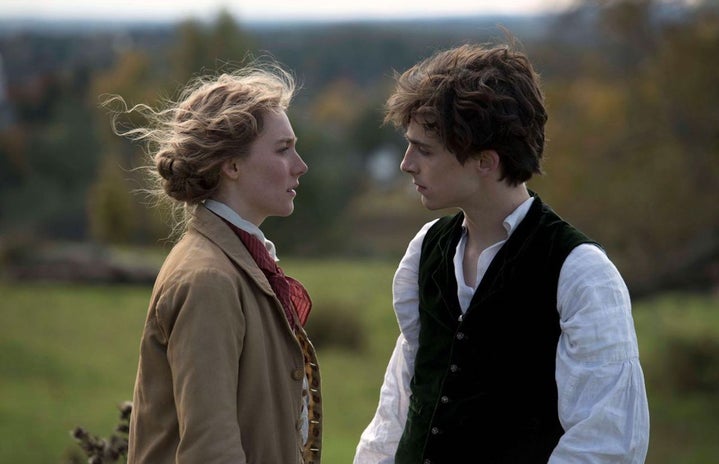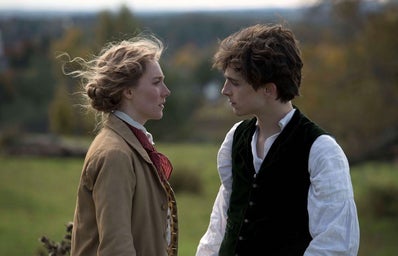It’s a typical crisp fall night. You put on a silk two-piece pajama set with pumpkins on it and pull on your coziest pair of fleece socks. You flip the switch on your kettle and prepare a pumpkin spice tea bag that fills your dorm with its sweet aroma. With your autumnal tea in one hand and the TV remote in the other, you plop down on the couch. You pretend to flip through the endless fall movies and TV shows, but you already know what you’re going to watch: “Little Women.” A tale of 4 sisters as they navigate girlhood, sisterhood, and relationships in 19th-century Massachusetts. You go to type it into the search box and instantly you are hit with the hardest choice of the night. Should you watch the 1994 version or the 2019 version? Anxiously, you search online for the answer and find this article. You are in luck; you are in the right place.
1. The Character debate
When doing an analysis of the better movie the 1st measurement that came up was Characters. The 5 main characters that I will compare are the March sisters: Meg, Jo, Beth, and Amy. A deeper analysis might include Theodore “Laurie” Lawrence, Marmie, Freddy, and John Brooke but for the sake of time I will stick to the “Little Women.”
Starting with Meg and right off the bat the 1994 version played by Trini Alvarado prevails over the 2019 version. Now don’t get me twisted. I love Emma Watson who plays the 2019 version of Meg but where she falls is her accent. Emma Watson attempts an American accent but many times in the film you can see her slip up and reveal her true English accent. Trini Alvarado plays an almost perfect Meg who is caring, motherly, and romantic. Point 1994!
Moving onto Beth, who is the only one of the sisters who suffers a tragic ending with her death due to Scarlet Fever. Beth is quiet, musically inclined, and nostalgic; it’s a hard character to mess up. Both actresses who play Beth do an excellent job portraying the beloved character, but I have to hand it to Eliza Scanlen for really selling me on the character. We get so much more of Beth’s shy but kind personality in the 2019 version and her love for playing the playing the piano shines through. Point 2019!

Amy is the youngest sister in the March family and exhibits every stereotypical little sister trait. She is envious, self-assured, romantic, and at times a little bit annoying when she is a kid. Amy is an interesting case because she grows so much throughout the film. So much so that in the 1994 version she is played by two different actresses’; one for childhood and one for young adulthood. But in the 2019 version, Florence Pugh plays both 12-year-old Amy and 18-year-old Amy. (Shoutout to hair and makeup that was able to make this happen!) Surprisingly to me, the performance is very convincing! I didn’t mind that a 22-year-old was playing a 12-year-old in part because of Florence Pugh’s amazing acting prowess. I do, however, have a lot of love in my heart for Kirsten Dunst’s performance as young Amy which is just so pure to the books. Personally, Samantha Mazis’s performance of older Amy March, and Amy and Laurie’s sudden relationship is where the 1994 version fell flat. I believe Greta Gerwig’s decision to have Florence Pugh play both younger and older Amy March was genius because it felt more consistent and like she was playing the same character just older! Her speech about what it means to be a woman is so iconic and meaningful to the period it’s set in but also can be applied to today; I just love Greta’s mind! Point 2019!
Last and certainly not least is the character Jo March. Jo March is by far my favorite character in the movie just because of how much I relate to her. She is a passionate writer who stands up for what she believes in and stubbornly reaches for her ambitions. Now what I’m about to say is controversial, but I like Saoirse Ronan’s portrayal a LITTLE bit better than Winona Rider’s. Don’t get me wrong Winona Rider is MOTHER and plays an amazing Jo but a few things tip Saoirse Ronan’s Jo over Winona’s. First off, Jo’s anger and passion are better portrayed in the 2019 version. While Winona’s version is more faithful to the book, I just can’t help but relate to Saoirse Ronan’s Jo. Greta Gerwig’s writing is also what makes 2019 Jo stand out. The feeling of being trapped between preferring to be loved than love and not wanting to lose your freedom and individuality is something I felt deeply. I also loved how Sapphic coded that 2019 Jo is and how her ending is up to interpretation. The viewer can either interpret the ending as Jo getting married in real life and the book or only getting married in the book due to the publisher’s wishes and continuing being a single woman in real life. This was an ending not offered in the 1994 version but was a detail that deepened her character. And by a ridiculously small margin…The point goes to 2019! (I love you so much Winona Rider, please don’t hate me!)
2. Tie breaker (CinematogRaphy & Plot)
Oh no! We are all tied up. I don’t do “ties,” so I offer you two more points towards…”Little Women” 2019. Number 1: Cinematography. I love the stylistic choice in the 2019 version to make the childhood clips more saturated and warmer and the adulthood clips a darker and bluer film. Since we know Jo is the writer of “Little Women” and the books and movies are the retelling of her childhood, it is only right that she sees her childhood through rose-colored glasses. This also makes it easier for the viewer to distinguish between childhood and adulthood since the clips are spliced and not told linearly. This is the second thing I like about the 2019 version. Linearly I feel like the story of “Little Women” is more realistic but way more depressing. Linearly the story of “Little Women” gets very bleak as time goes on with Beth’s death and the struggles of adulthood. I find that having these clips spliced up makes the movie easier to watch because more depressing clips are followed by warm-colored clips of the March sister’s vibrant childhood.
So, the next time you’re deciding between “Little Women” (1994) and “Little Women” (2019) my advice is…watch both! Have a 3-hour and 30-minute full movie marathon with your friends and decide for yourself which one you like better! Do you prefer Timothee Chalamet or Christian Bale, Mother Winona Rider, or Saoirse Ronan? They are both amazing movies that each have their own quirks and personalities that are sure to uplift your spirits and give you that feeling of nostalgia! I hope these movies give you the sense of comfort and happiness that they give me, every fall when I sit down to rewatch them again.







